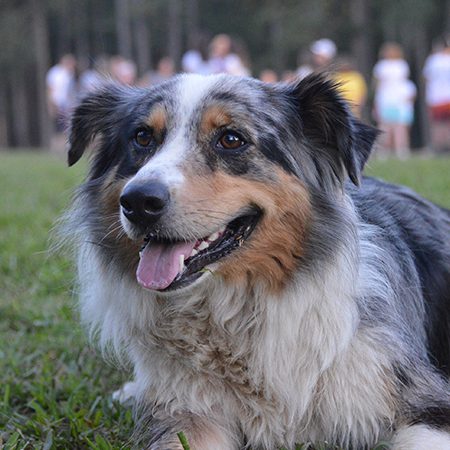Domestic Dog
Canis lupus familiaris
In terms of family and genus, the domestic dog is considered a subspecies of the wolf. The dog is believed to be the first species to be domesticated, and has since been selectively bred over millennia for various behaviors, sensory capabilities, and physical attributes. Their long association with humans has led dogs to be uniquely attuned to human behavior and cues, and has developed a digestive system that can thrive on starch-rich foods, that would be inadequate for other candid species.
Dogs vary drastically in shape, size, and colors. Over time, they have been trained and bred to perform many roles for humans, such as, hunting, herding, pulling loads, protection, assisting police, companionship, aiding disabled people, and therapy. Seeing how closely integrated these animals are with humans shows how the influence of “man’s best friend” came about. The origin of the domestic dog evolves from the divergence of the wolf, folowed by its domestication, and eventual development into dog types and dog breeds. The genetic divergence between dogs and wolves occurred between 20-000 - 40,000 years ago. Where the domestication of the dog took place still remains debated, most plausibly spanning Western Europe, Central Asia, and East Asia.
Dogs are highly variable in height and weight. The Chihuahua is the smallest known adult dog, standing 5 - 10 in tall, weighing only 3 - 6 lbs. The largest known dog was an English Mastiff weighing 343 lbs, and was 8 ft from snout to tail. The tallest dog is a Great Dane, standing 4 ft at the shoulder.
Say Hello To Cub Creek's Dogs: Nova, Tank, and the Kennel Dogs
Nova is camp’s Australian Shepherd. She can be found running around camp with a stick in her mouth or playing fetch with a stick! Nova belongs to the owners, Scott and Lori Martin! This Great Dane, Tank, is camp’s newest dog. Tank came to us in 2018 from a home who had abandoned him and two small dogs. Tank was meant to be here all along with his bounding run and endless energy. Every summer, we partner with local shelters to find dogs permanent homes. They live in our kennels during the summer. We use the care and attention provided by our campers, ASITs, and staff to strengthen these dogs social skills. If you are looking for more information you can talk to our Director of Animal Care, Natalie.

Domesticated dogs range across North America and other developing countries.
HABITAT -Most domesticated dogs live in habitats symbiotic to humans, with feral populations living in urban environments.
DIET -There are both dry and wet food options, with feral dogs foraging in the wild.
FUN FACT -Dogs and humans have the same type of slow wave sleep, with rapid eye movement, meaning that dogs can dream!
SOCIAL BEHAVIOR -Domesticated dogs are very comfortable social companions to humans, feral dogs tend to limit their human interaction.
ACTIVITY -Domesticated dogs tend to adjust their activity to their human owners, while feral dogs are crepuscular.
PREDATORS -Predators of domestic dogs include, bears, coyotes, and mountain lions.
SIZE -Size varies drastically by breed with small toy breeds weighing 4 oz and larger breeds weighing 340+ lbs.
RELATIVES -Domesticated dogs are most closely related to the Grey Wolf, which it is believed to be domesticated from.
CONSERVATION -Domesticated dogs are Not Listed on the IUCN Red List.
Cub Creek Animal Care Information
Housing - We work with local animal shelters to help provide permanent homes to stray cats and dogs every year! When we get cats & dogs from the shelter, they live in our state of the art kennel yard and adjacent cat lounge. The kennel yard has a covered portion providing shelter, this is built on top of a large concrete slab, with individual dog houses separated by fencing. The other portion of the kennel yard is made up of a large open area, fenced in to keep predators out. The outdoor area is covered in green grass, mulch, and sprinkled with trees for shade. We even have kiddie pools, a hose, and everything needed to give them baths during the summer!
Diet - All of our dogs are fed high quality dog food, the amount is dependent to the dogs breed / weight. This food provides all of the daily nutrition they need, of protein, vitamins, and minerals. Of course they also get special crunchy or chewy treats occasionally!
Enrichment - Working with so many dogs over the course of camps history, the Adopt an Animal program for dogs has grown and become very popular! All of the dogs we receive get a lot of one on one attention and social interaction. They get plenty of toys to play with, some donated to camp and others that are made for enrichment by campers. We give them baths, they have time to walk in the yard, and will go on walks around camp. We’ve also implemented a training program, to continue training and enrich their lives.


